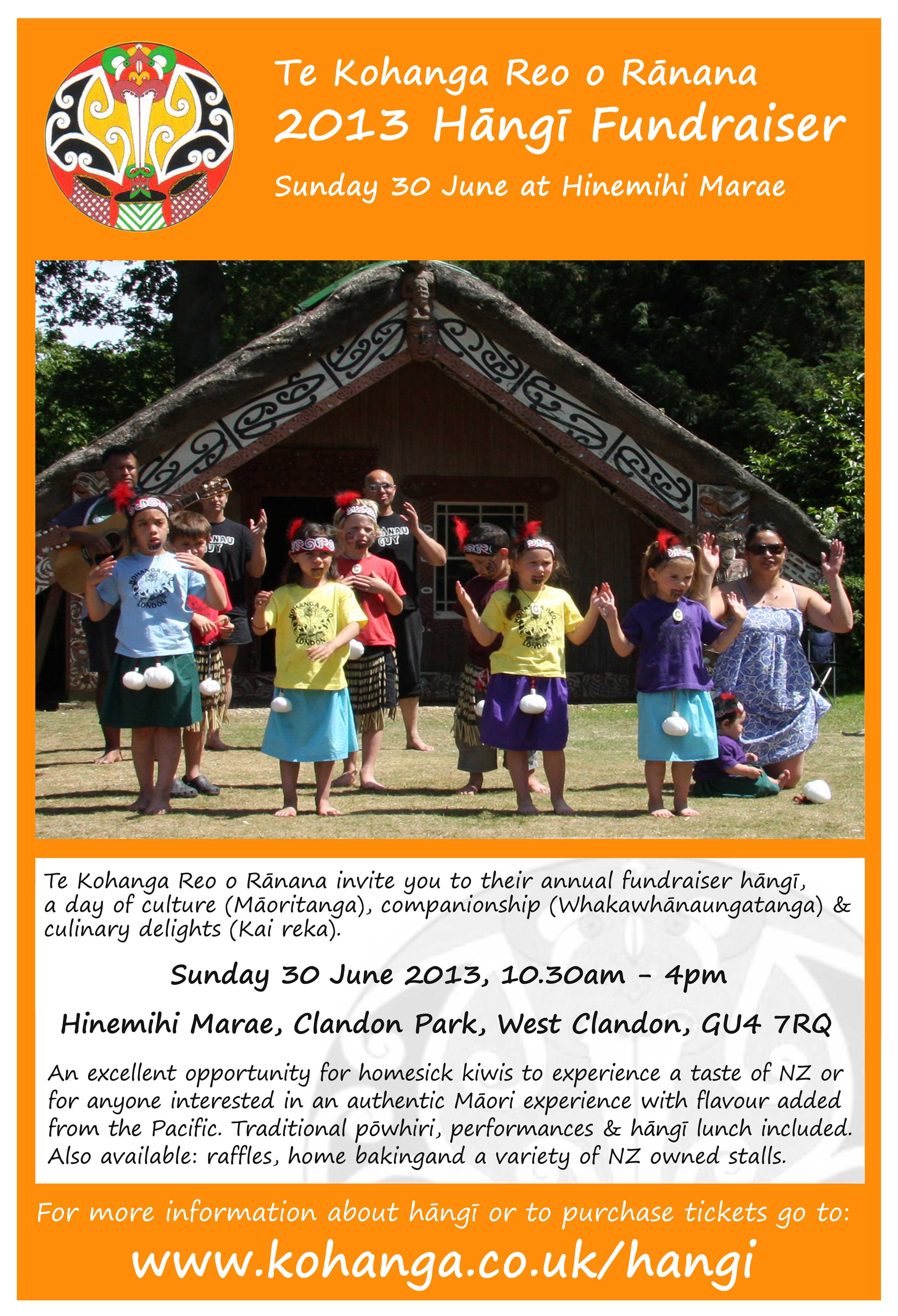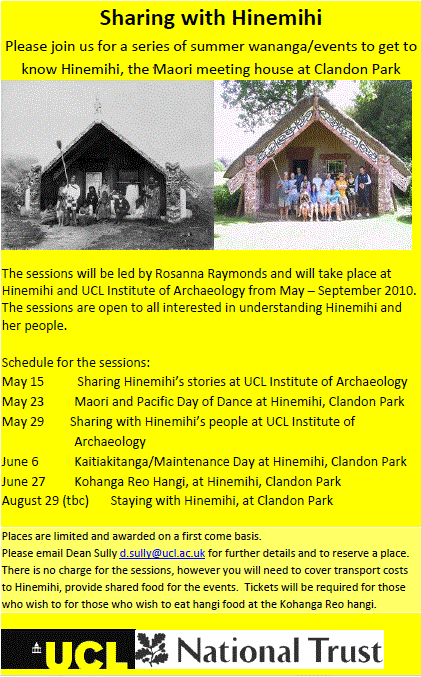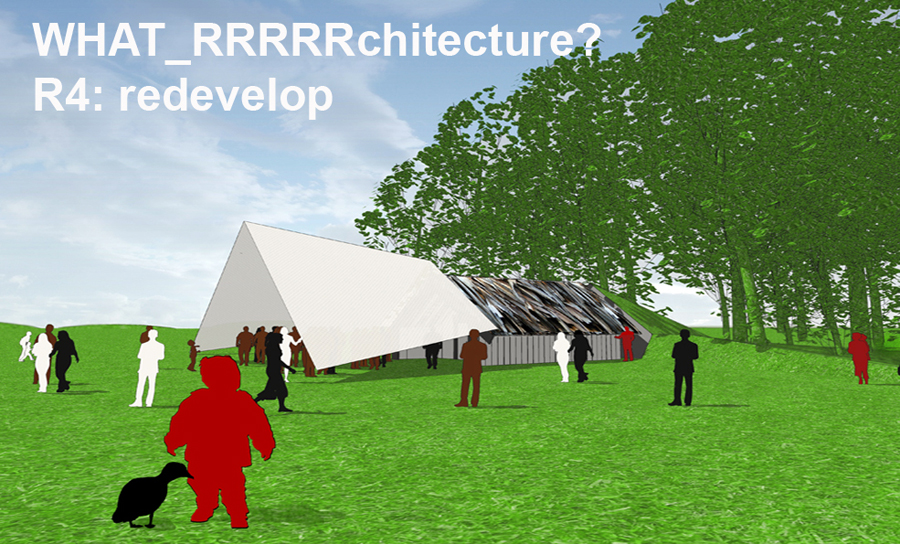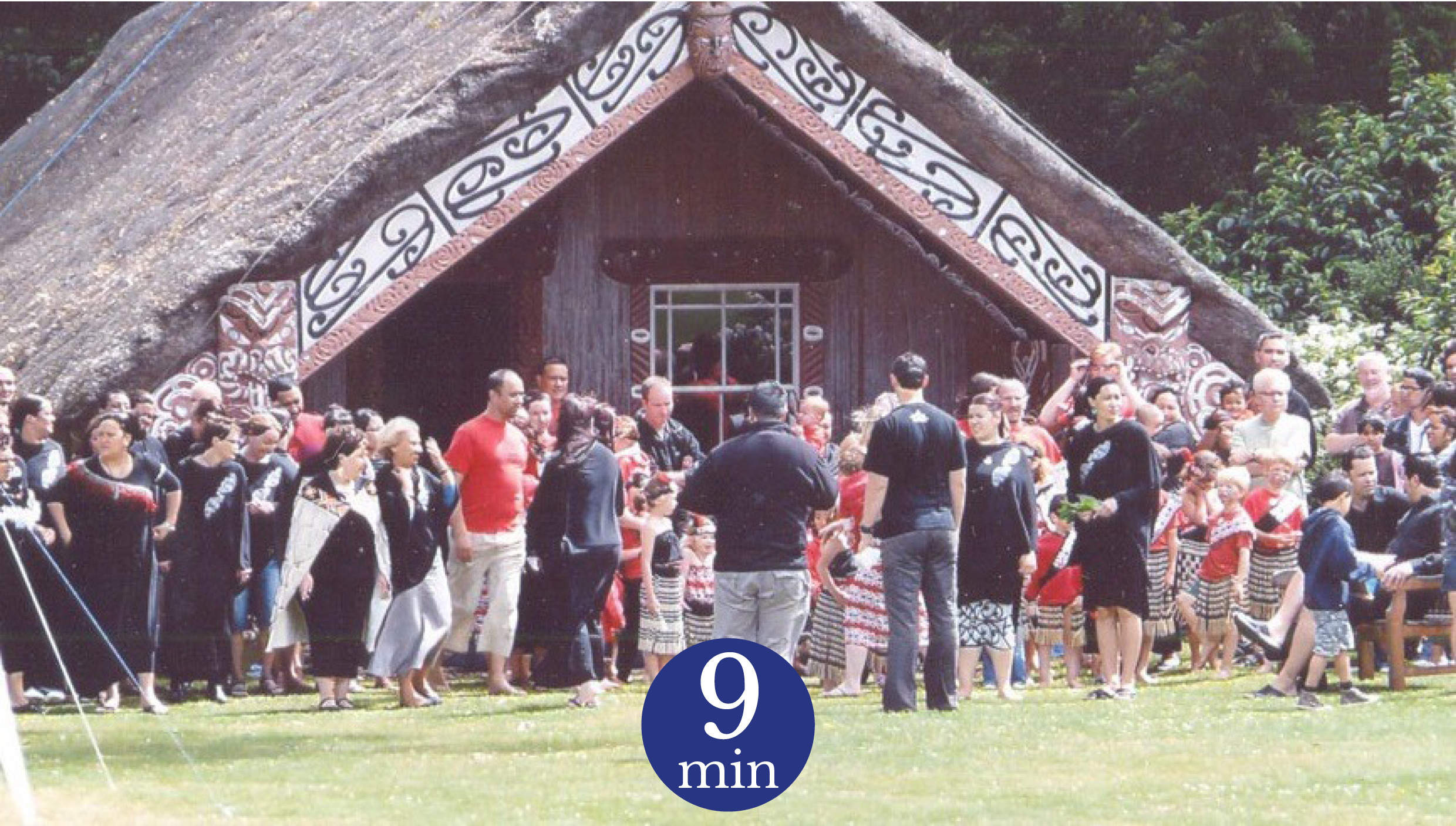« […] Yes, I am there to welcome you … we lament the dead
I wait for the whaikorero to start,
Yes, you acknowledge me, and I you
I wait for the tamariki, they on my paepae
Yes, I cry, for they fill me with pride and hope
I wait for the rhythm of the kapahaka…
Yes, I can dance along … I know your songs
I wait for the smell of the kei to emerge from the ground,
Yes, I will eat with you and you with me
We feed a need to perpetuate the past and the present
And in doing so we bring forth Rongomatane and Papatuanuku
So who invited Tu ? »
So who invited tu ?, Rosanna Raymonds
*Switch language to french for french version of the article*
Let us take up the course of Hinemihi's history where we left off in the previous article. The second half of the twentieth century was an opportunity for Hinemihi to reconnect to a network of socio-cultural relationships that had been destroyed during her exile, but it remains limited. Ngati Hinemihi remains geographically distant from Hinemihi, and the ability of the UK-based māori community to keep it going faces some limitations.
The first are purely practical: lack of personal time, remoteness from London, poor public transport links, accessibility issues as there is a charge for access to the Clandon Park residence although there is an informal arrangement for those who only want to see Hinemihi (which is not always respected). The English climate also plays an important role, as Hinemihi has a dirt floor, is not thermally insulated, nor is she heated or connected to electricity (and therefore not lit). These conditions mean that she is visited and used during the summer months only.1

Leaflet for the Kohanga Hangi of 2013. Source : http://www.hinemihi.co.uk/page.php?id=23&page=57
The second is related to the British māori community's questioning of its identity. Firstly, all its members come from diverse māori communities, which leads to protocol and cultural differences that are sometimes difficult to manage. Secondly, it is a rather young and temporary community (although some families have been in the UK for several generations).2 It is therefore complex to develop a stable 'core' of older people with sufficient 'traditional' knowledge to ensure their legitimacy to conduct certain ceremonies as many do not necessarily feel comfortable in this role.
Despite the willingness of both groups to take care of Hinemihi, they recognise that the organisation is not sufficient, and that more rigorous associative and institutional structures still need to be put in place to ensure Hinemihi's socio-cultural well-being. The issue of her material preservation is still important, because despite frequent restoration campaigns, her outdoor location implies a continuous degradation that requires frequent maintenance.
Since the 1990s, the National Trust has shifted its paradigm of approach to heritage preservation. With a greater emphasis on the social and community, to reflect on the full range of cultural meanings to which the heritage it conserves might be linked.3 This shift has put collaborative conservation management of Hinemihi back on the table (which was initially rejected in 1995 despite the recognition of Ngati Hinemihi's link to the whare).
A study of its state of preservation and the stratigraphy of the paint layers was carried out by students at University College of London (UCL) from 2003 onwards to provide a basis for collaborative conservation choices (the option of whether or not to carry out this material study, including stratigraphic samples, had been sought from the two māori communities involved, and blessings were given by Ngati Ranana before the study began).4 Since 2004, the organisation of 'Maintenance Day' began to carry out minor renovations before the Kohanga Reo Hangi in June. It is a meeting point for National Trust volunteers, the māori community and UCL students. The day creates a network of relationships between people from different communities centred on Hinemihi, which is a way of passing on māori knowledge to younger generations as well as a gateway to this culture for non-māori people.5

Advertisement for the "Maintenance day" of 2012. Source : http://www.hinemihi.co.uk/media/120806-1258-Maintenance2012poster.pdf
In the same year, a formal consultation with Ngati Hinemihi and the UK-based māori community was launched to form a group of 'stakholders'. Discussions revealed that the māori will was not to return the whare to a physical historic state of pre-eruption existence (as the NT believed) but rather to make her more suitable for ceremonial and cultural activities (flooring, insulation, electricity, etc.).6 In short, stakholders wanted the conservation project to focus on the present and the needs of contemporary māori culture. It was therefore decided to adopt a conservation project that did not focus on the historicity of Hinemihi but on her existence as a central object in a network of socio-cultural relationships whose members come from different backgrounds.
In the late 2010s, the NT proposes to try to make Hinemihi function as a marae within the formal consultation process, which is well received by Ngati Hinemihi and British māori. As a result of this process, there is a intention to identify 'Hinemihi's people', a community specifically built to form a sustainable support network for the preservation and management of Hinemihi.7 Hinemihi would also become a centre for the expression of māori culture in Britain, reaching out to the British public but also supporting diaspora communities seeking to define their specific identity as British māori, grouped together in a 'pan-tribal' urban community.8
This community would extend beyond Ngati Hinemihi and the British māori community. It would also include some New Zealand institutions and associations, the New Zealand (non-māori) and Polynesian communities in the UK, and the British public (visitors to Clandon Park, National Trust volunteers, academics and students, local artists and residents). In addition to the annual public events organised by the māori cultural associations, specific community building events have been organised. These take place within the 'whareNOW' programme9 which is a collaborative partnership between the māori and Polynesian communities in the UK and UCL in place since 2009. It aims to develop shared community goals, to encourage and document the relationship between Hinemihi and her 'people' (discussion, workshop, knowledge sharing, website...). It also hopes to move beyond Hinemihi's physical isolation to better integrate her into the lives of her 'people' in Aotearoa and the UK. It is part of a wider research project investigating participatory conservation methods and the use of alternative epistemologies in cultural heritage preservation.10
The WhareNOW programme is seen as the first step in deepening the relationship between Hinemihi and her people, with the aim of creating a stable community for her preservation. The first event (2009), organised at the request of the māori diaspora, was a parent/child wananga (workshop) with the aim of teaching māori cultural knowledge. The second (2010) was more focused on workshops in areas related to wharenui conservation11 (carving, painting, weaving). This resulted in the creation of the Te Maru o Hinemihi ('in the embrace of Hinemihi') association in 2012, which is the first manifestation of an organised structure to effectively monitor the preservation of Hinemihi to bring together individuals and not community groups (in collaboration with the NT and key cultural stakeholders, some of the members of this association are from Ngati Hinemihi or the māori diaspora in Britain).12

Advertising poster for the promotion of various events on the theme of "Sharing with Hinemihi". Source: http://www.hinemihi.co.uk/media/120904-1757-Sharing%20With%20Hinemihi%20release.pdf.
The association conducted a survey between 2012 and 2013 among "Hinemihi's people" to determine future conservation strategies by proposing 5 options. These are the "5 Rs": Repair (physical preservation of the existing form, a kind of status quo), Restore (restoration of Hinemihi to an earlier form, such as that of 1880), Reuse (rehabilitation for contemporary use: new floor, insulation, electricity,... in addition to her 'restoration'), Redevelop (the two previous points plus the construction of subsidiary places nearby to allow her use as a real marae), Relocate (moving it to a place more suitable for her conservation, such as a museum, or even repatriation to Aotearoa)13. In 2013, the results of this survey concluded that there was a preference for "R4", 14 i.e. redevelopment to make her a much more functional place for cultural activities by adding secondary building, in particular kitchen and hygiene facilities (toilets, showers, etc.). There is also the idea of a permanent or easily deployable canopy to shelter performances in case of bad weather. However, following the fire at the Clandon Park residence in 2015, this process has been slowed down considerably. Some of the sculptures have been removed to slow down their degradation and protection has been installed over the roof.15

Example of a future projection for "redevelop": a canopy and a half-buried annex project behind Hinemihi to fit into the landscape of the park. Source: http://www.hinemihi.co.uk/media/120807-1548-REDEVELOP.jpg.
The Hinemihi conservation project is a good example of how participatory conservation practices have evolved. The original socio-cultural community, Ngati Hinemihi, was ignored for most of the twentieth century and eventually came to prominence with its gift of sculptures to the National Trust, which sealed the beginning of their relationship. However, it remained rather unequal until the early 2000s, as it depended on the goodwill of the National Trust. It is only in the early twenty-first century that attention begins to be paid to the communities socially, culturally and historically connected to Hinemihi and their views on her conservation. The pre-eminence of Ngati Hinemihi's responsibility over other māori groups for her preservation is obvious according to the tangata whenua. However, geographical distance is a major obstacle to physical participation in her preservation, both materially and spiritually. The identification of the British māori community as delegates who are able to carry out these tasks occurs at the same time as Ngati Hinemihi's re-appropriation of the wharenui. But as described above, this was insufficient for the material and spiritual preservation of Hinemihi. The conservation project then turned to the search for "Hinemihi's people", a network of relationships centred around her and forming a community capable of ensuring her preservation. It is therefore not only a question of identifying and restoring the original socio-cultural context but also to create a new one. The conservation goal was to encourage the creation of part of this socio-cultural network. The new relationships created are products of the conservation project. In addition to the wharenui's own preservation, the project adds new issues. Firstly, the expression of māori culture within the UK; Hinemihi is a meeting point with this culture for the British. It asserts its place within this multicultural state but is also a means of evoking the colonial question. Hinemihi is also a space for reflection on British māori identity and its link with the tangata whenua.
This type of project, which moves away from the material object in itself to better serve it, is still very singular in the landscape of the conservation studies (especially in Europe). In this project, conservation broadens its issues and therefore its social and political scope, 16, which allows heritage preservation issues to gain visibility. The collaboration between different stakeholders and the use of participatory methodologies have opened new and enriching perspectives for the preservation of Hinemihi.
Morgane Martin
Cover picture : Event « Being with Hinemihi », 2009.
http://www.hinemihi.co.uk/media/121113-1903-Being-with-Hinemihi-Image-5.jpgstream/
1 BURROWS, K., 2007. « Hinemihi and the london maori community ». In SULLY, D., (ed.), Decoloninsing Conservation : Caring for maori houses outside New-Zeland. Walnut Creek (CA), Left Coast Press, p. 165
2 According to Burrows's article (2007), these demographic trends may have changed since 2007.
3 DELONG LAWLOR, J., LITHGOW, K., 2007. « The National Trust and Hinemihi at Clandon Park ». In SULLY, D., (ed.), Decoloninsing Conservation : Caring for maori houses outside New-Zeland. Walnut Creek (CA), Left Coast Press, p. 150.
4 SULLY, D., POMBO CARDOSO, I., 2007, « Conserving Hinemihi at the Clandon Park, UK ». In SULLY, D., (ed.), Decoloninsing Conservation : Caring for maori houses outside New-Zeland. Walnut Creek (CA), Left Coast Press, p. 207.
5 SULLY, D., RAYMOND, R., HOETE, A., 2014. « Locating Hinemihi’s people ». Journal of Material Culture, vol. 19, n°2, p.12.
6 SULLY, D., POMBO CARDOSO, I., 2007, « Conserving Hinemihi at the Clandon Park, UK ». In SULLY, D., (ed.), Decoloninsing Conservation : Caring for maori houses outside New-Zeland. Walnut Creek (CA), Left Coast Press, p. 217.
7 SULLY, D., RAYMOND, R., HOETE, A., 2014. « Locating Hinemihi’s people ». Journal of Material Culture, vol. 19, n°2, p. 3.
8 SULLY, D., RAYMOND, R., HOETE, A., 2014. « Locating Hinemihi’s people ». Journal of Material Culture, vol. 19, n°2, p. 8.
9 SULLY, D., RAYMOND, R., HOETE, A., 2014. « Locating Hinemihi’s people ». Journal of Material Culture, vol. 19, n°2, p. 3.
10 SULLY, D., RAYMOND, R., HOETE, A., 2014. « Locating Hinemihi’s people ». Journal of Material Culture, vol. 19, n°2, p. 10.
11 Activities that follow the New Zealand model which promotes the conservation of māori heritage through direct community participation in the form of technical workshops that pass on knowledge across generations. Participants from all backgrounds are welcome.
12 SULLY, D., RAYMOND, R., HOETE, A., 2014. « Locating Hinemihi’s people ». Journal of Material Culture, vol. 19, n°2, p. 3.
13 SULLY, D., RAYMOND, R., HOETE, A., 2014. « Locating Hinemihi’s people ». Journal of Material Culture, vol. 19, n°2, p. 14.
14 http://www.hinemihi.co.uk/page.php?id=21&page=142&subpage=126, accessed on 10/06/2020
15 https://www.nationaltrust.org.uk/clandon-park/features/restoring-hinemihi-at-clandon-park, accessed on 10/06/2020
16 SLOGGETT, R., 2009. « Expanding the conservation canon : Assessing cross-cultural and interdisciplinary collaborations in conservation ». Studies in Conservation, vol. 54, n°3, p. 180.
Bibliography:
- BURROWS, K., 2007. « Hinemihi and the london maori community ». In SULLY, D., (ed.), Decoloninsing Conservation : Caring for maori houses outside New-Zeland. Walnut Creek (CA), Left Coast Press, pp. 161-172.
- DELONG LAWLOR, J., LITHGOW, K., 2007. « The National Trust and Hinemihi at Clandon Park ». In SULLY, D., (ed.), Decoloninsing Conservation : Caring for maori houses outside New-Zeland. Walnut Creek (CA), Left Coast Press, pp. 149-159.
- RAYMONDS, R., 2007. « So who invited tu ? ». In SULLY, D., (ed.), Decoloninsing Conservation : Caring for maori houses outside New-Zeland. Walnut Creek (CA), Left Coast Press, p. 147.
- SLOGGETT, R., 2009. « Expanding the conservation canon : Assessing cross-cultural and interdisciplinary collaborations in conservation ». Studies in Conservation, vol. 54, n°3, pp. 170-183.
- SULLY, D., POMBO CARDOSO, I., 2007, « Conserving Hinemihi at the Clandon Park, UK ». In SULLY, D., (ed.), Decoloninsing Conservation : Caring for maori houses outside New-Zeland. Walnut Creek (CA), Left Coast Press, pp. 199-219.
- SULLY, D., RAYMOND, R., HOETE, A., 2014. « Locating Hinemihi’s people ». Journal of Material Culture, vol. 19, n°2, pp. 209-229.
- To go further and to keep in touch with Hinemihi :
- http://www.hinemihi.co.uk/
- She also has a facebook page : https://www.facebook.com/Hinemihi-142890949180803/.
